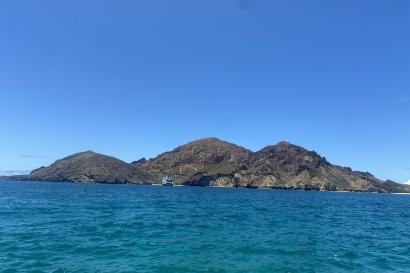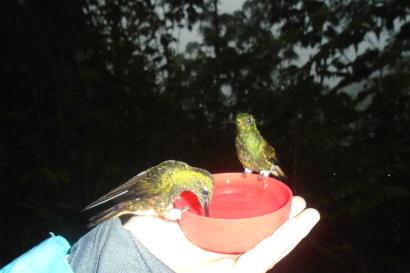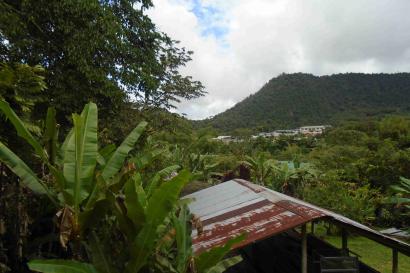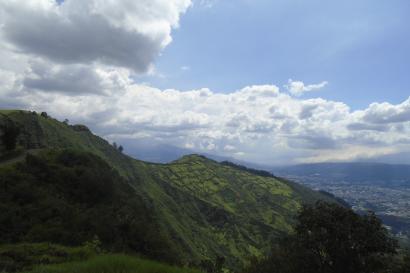Most recorded history frames the Galápagos Islands as a pristine, untouched wilderness. Finches flitting into conewells of prickly pear nectar. Woody roots tangling over lava rock. According to legend, Darwin’s was the first foot trod onto the sand. Post-Darwin, the record gives a slow, incoherent hum. During my pre-departure research before I embarked on this program, every time I googled “Galápagos people,” the results pages were barren: only a few opinion articles on why all the land belongs solely to wildlife. I couldn’t help but think something was hiding here. When I arrived, I felt an obscure placelessness everywhere. Sure, the finches are fascinating. Sure, the shapes of their beaks imply the absence of a God. Sure. But what happened here, really? Like much of the true history of this world, you hit a wall: a wall with paint so thick and so hard that there must be a mural beneath it.
We are sold an image of the Galápagos as pure nature. In this grand story, there is very little (if any) information on the history of Galápageños, the people who inhabit the islands. Yet, when you walk the Malecón on San Cristóbal or Santa Cruz, the sidewalks are bustling with people. The neighborhoods hum with conversations over balconies and cross-street salutations. The framing of the Galápagos as “wild” relies on a deliberate silencing of the archipelago’s history and present. When my political ecology class visited Hacienda Guadalupe, the farm of Milton Aguas, we learned that Galápageños have lived here for decades, despite efforts to keep them out of sight. Many of the inhabitants of San Cristóbal are descendent of agricultural labor drafts from Ecuador’s mainland, first as forced labor in Manuel Julián Cobo’s sugar plantation in the 1880s, then in the 1940s and 60s as the Ecuadorian government encouraged farmers to develop the islands for cash. The turning point came in 1959, when the penal colony of Isabela shut down and the archipelago, once seen as a brutal hell, was declared a national park. This is the start of the “ecological preservation” of this place.
Around that same time, the U.S. Wilderness Act (1964) defined wilderness as “an area where the earth and its community of life are untrammeled by man, where man himself is a visitor who does not remain.” In the U.S., wilderness justified the forced removal of Native peoples from their ancestral territories to create “fortresses” of “untouched” nature like Yosemite. The U.S. National Park system created the narrative of pristine wilderness, upholding the myth of the frontier. That people and nature are two distinct systems, that we must separate humans from nature to “preserve” it.
I am telling this story deliberately in a public forum:
Before the Galápagos became a bucket-list ecological destination, they were what sociologist Jason W. Moore calls “cheap nature.” In the 19th century, they exported sugar cane and tortoise oil. Even the name of the Galápagos comes from its ability to produce: “galopar,” to gallop, for the seat-shape shell of the saddleback tortoise. To create a tortoise of a horse is to imply profit, that this island will work as horses turn dials on sugarcane presses.
Then, in 1978, UNESCO declared the Galápagos a world heritage site. The narrative shifted to one of salvation for the endangered species that were once hot commodities on the global market. Did you know, Las Vegas, Nevada has the second-highest population of Galápagos tortoises in the world? Now, to uphold the idea of wilderness, tourism was developed in selective maritime routes to remote places, away from people. This is where extractivism ends, and the myth of the Galápagos as pristine, untouched wilderness begins. With this shift, local inhabitants became strangers to the land. Their rights to the island came into question for the sake of the survival of the finches. Scientists now speculate on the morality of human presence on the island, debate the costs to wildlife over human life.
While there may be no indigenous peoples of the Galápagos, local communities have lived on San Cristóbal for generations self-sufficiently before tourism developed. Ironically, it is the tourism of wilderness that requires abundance of workers, restaurants serving food imported from the continent, and a heavy flow of fossil fuels to run boats and air conditioners. This industry imports everything, dismissing fishermen and farmers who remain invisible “cheap nature.”
Who is most deserving of the Galápagos’ nature? The animals? The scientists? The workers drafted here, then discarded and hidden? Who is nature protected for? As I spend more time in the Galápagos, I start to see the mural peek through the bark in the wilderness. The utopia hides a process of wastelanding. Not only are the streets wastelanded, covered in tourist litter, but the people are wastelanded too. The stories of Galápageños are not worth telling in official history, as the Charles Darwin foundation has made clear: here, sea lions count, not humans. In the name of wildlife, international conservation advises against local economies and allocates funds to strengthen the narrative that suits them best: the preservation of wilderness. All of the water in the settlement is contaminated with E. coli, yet they have genetically recreated the original Galápagos tortoise. Priorities are clear. Here, the animals matter more than people. Rather, the animals strike better gold. Humans are wastelanded to uphold that narrative to the world.
Sources:
Jason W. Moore: The Rise of Cheap Nature
Mark Dowie: Conservation Refugees: The Hundred-Year Conflict between Global Conservation and Native Peoples
Guadalupe and Milton Aguas
Doménica Guerrero (@domenaturalist on Instagram)

Anna Sverclova
My name is Anna Šverclová. I'm a published poet and creative writing major at Macalester College. I love exploring the world around me. You can almost always find me digging in the mud by the river, journal in my back pocket. My writing focuses on my relationship with the world, childhood trauma, and my hometown. I write both for the page and for performance. You can find me at annasverclova.com








